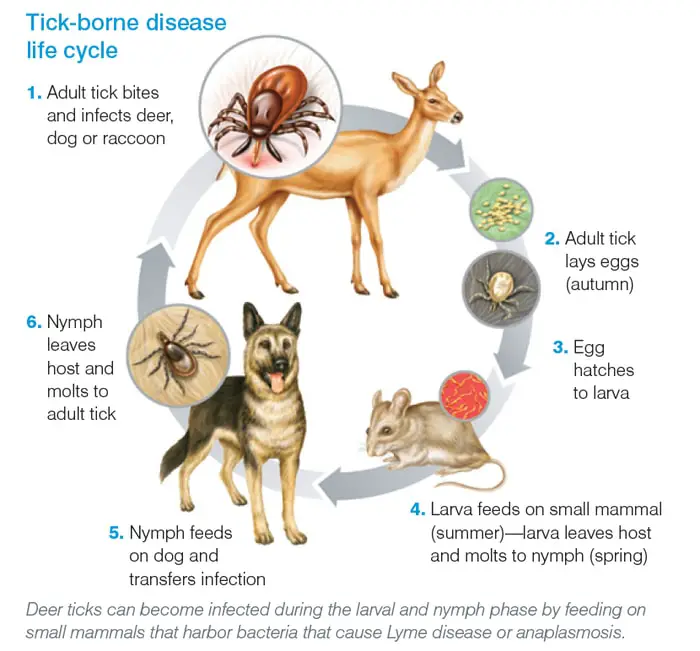Lyme disease in dogs is a multisystemic infectious bacterial disease arising from infection with the Borrelia burgdorferi and was first described by Willy Burgdorfer in children with sudden onset of polyarthritis and erythematous skin rash in Lyme, Connecticut, the USA in 1975. Borrelia burgdorferi is epizootic and transmitted by ixodid ticks (blackleg) Ixodes dammini, Ixodes pacificus, and Ixodes ricinus. Another tick Ixodes persulcatus is the primary vector of the disease in Asia and Europe.
Importance of Lyme Disease in Dogs
Lyme Borreliosis or Lyme disease in dogs is a prevalent bacterial disease of your dogs that may transmit to you and other animals. The primary vector the condition is blackleg ticks, which are generally present in the grass, and kennel environment and quickly affects the dogs by sucking blood. These ticks suck blood from your dogs and infect with Lyme Borreliosis. So as a dog owner, you must have minimum knowledge of this disease.

Transmission of Lyme Borreliosis in Dogs
These ticks have initially been associated with deer and sheep but are now known to be carried by many small rodents, which are probably the primary reservoir hosts. All stages of the tick ( larva, nymph, and adult) can be competent vectors. Tick larvae or nymphs become infected when they take a blood meal from a reservoir host, many of which are persistently infected. The organisms are transmitted in salivary secretions during feeding and are secondarily transmitted to other mammals, including man, cats, horses, and dogs.

Can Lyme disease also Affect People?
Lyme disease also affects the people, but the dogs do not spread directly to the human. People get if from bitten by the same ticks and then transmit it to the dogs. However, if a tick crawls off your dog and bites you, you can become infected.

What are the Symptoms of Lyme Disease in Dogs?
The typical clinical signs are lameness, fever, anorexia, lethargy, and swollen lymph nodes. In lame dogs, single or multiple joints may be swollen and painful. The bones are swollen and painful. Other clinical manifestations that may be seen in your dogs include carditis, glomerulonephritis, and neurological symptoms, behavioral changes, aggression, and seizures. Untreated dogs may lead to damage to the kidney, brain, and heart. The clinical investigations include:
- Clinical examination for joint disease, neurological defects, carditis, pyrexia.
- Serology for Burgdorferi infection.
- Analysis of synovial fluid from affected joints shows cytological changes.
- Episodes of lameness typically last only a few days, and there are often associated with pyrexia and lymphadenopathy.

Diagnosis of Lyme Borreliosis
History of potential exposure to B. burgdorferi and Ixodid ticks. Seasonal incidence associated with peaks in tick activity, particularly the nymph or adult stages, which are more likely to transmit B. burgdorferi. The appropriate clinical signs including fever, malaise, lethargy, inappetence, lymphadenopathy, lameness, carditis (heart block), neurological symptoms, and, possibly, glomerulonephritis. Lyme arthritis should include radiographic evidence of a synovial effusion and synovial fluid analysis consistent with synovitis.

Many asymptomatic animals are positive for anti-Borrelia antibodies. Response to antibiotic therapy, Identification of B. burgdorferi in blood, urine, synovial fluid, CSF, or other tissues. Culture of B. Burgdorferi from blood, urine, synovial fluid, CSF, or other tissues. Eradication of other possible causes of similar clinical signs, including traumatic arthritis, osteoarthritis, and immune-mediated polyarthritis.
Treatment and Prevention of Lyme Borreliosis
Regularly treat your dogs with an effective tick control product, and you just have to ask your veterinarian, which is the best product for your lovely dog. Most antibiotics are useful, and you should be used for 3-4 weeks. Vaccination with components of B. burgdorferi is now commercially available. Regularly checked and should be brushed your dogs properly.

Other Canine Diseases Carried by Ticks
Ticks are carried several types of less common but bacterial severe diseases, including anaplasmosis and Babesiosis. Anaplasmosis and Babesiosis are more similar to the Lyme disease in dogs. The symptoms are more or less similar. The symptoms of Babesiosis are fever, weakness, lethargy, pale gums and tongue, jaundice, red or orange urine, enlarged spleen, and lymph nodes. Diagnosis of both diseases is blood tests which are similar to Lyme disease in dogs.

Final Advice on Lyme Disease in Dogs
Lyme disease is a common disease if you take preventive measures early. At the same time, it may become fatal if you left your dog untreated. The preventive measures that will reduce the incidence of the disease reduce the inhabitants of ticks in the kennel area, treat the lean with anti-tick substances, keep clean your dogs’ box and kennel, regular groom your gods and remove the ticks from the body, use vaccine against the Lyme Borreliosis.